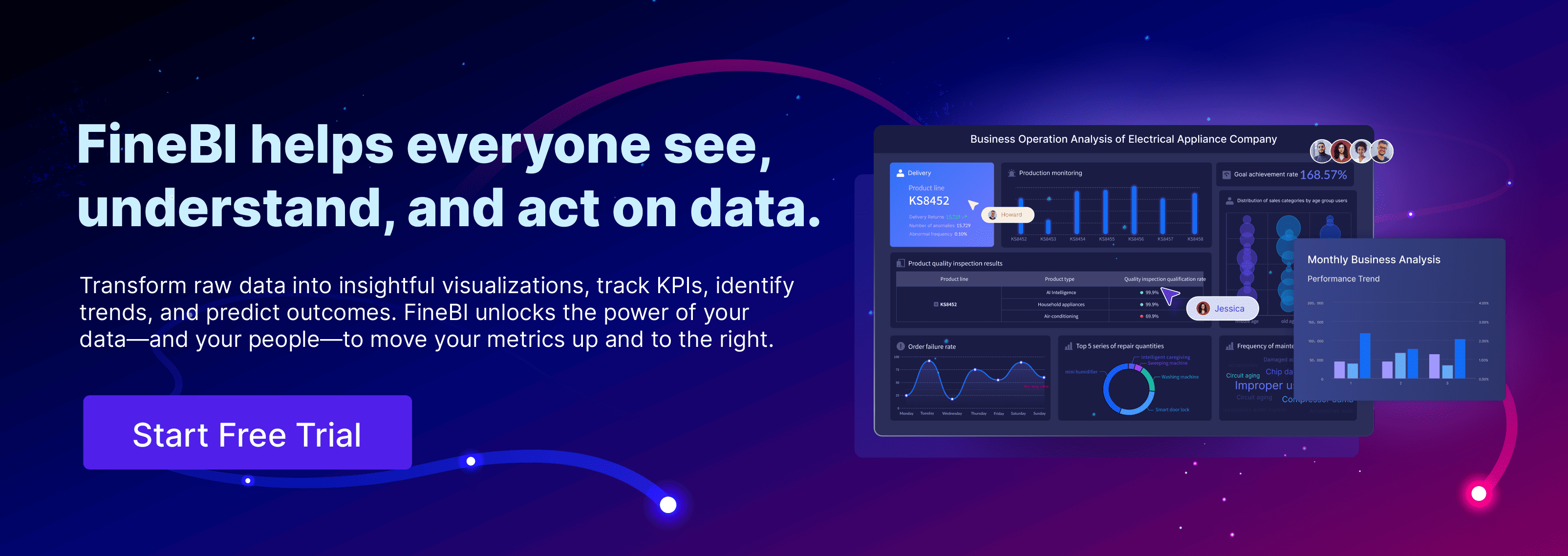Business intelligence vs business analytics are essential tools for modern enterprises. Business intelligence helps you analyze historical and current data to uncover patterns, trends, and insights. On the other hand, business analytics emphasizes predicting future outcomes and making data-driven forecasts.
Understanding the difference between these approaches is critical. With the global business intelligence market projected to grow to $116.25 billion by 2033, knowing when to analyze past data versus forecasting future trends can give your enterprise a competitive edge. Additionally, only 32% of executives report deriving measurable value from data, emphasizing the need for clarity in these concepts.
Business Intelligence vs Business Analytics: What Is Business Intelligence?
Definition of Business Intelligence
Business intelligence refers to the process of collecting, analyzing, and transforming raw data into actionable insights that guide decision-making. It involves using technology-driven tools and methodologies to evaluate historical and current data, enabling you to identify trends, patterns, and opportunities. Business intelligence tools empower organizations to make informed decisions by presenting data in a structured and visual format, such as dashboards and reports.
At its core, business intelligence focuses on answering questions like "What happened?" and "Why did it happen?" By leveraging these insights, you can improve operational efficiency, enhance customer experiences, and gain a competitive edge in your industry.
Key Features of Business Intelligence
Business intelligence tools offer several features that make them indispensable for modern enterprises. These include:
- Data Integration: Business intelligence tools consolidate data from multiple sources, such as databases, spreadsheets, and cloud platforms, into a unified view. This ensures that you have access to accurate and consistent information.
- Real-Time Analysis: With real-time data processing, you can monitor key performance indicators (KPIs) and respond to changes as they occur.
- Interactive Dashboards: These tools provide customizable dashboards that allow you to visualize data through charts, graphs, and tables. This makes it easier to interpret complex information.
- Self-Service Analytics: Business intelligence tools enable non-technical users to perform data analysis independently, reducing reliance on IT teams.
- Predictive Insights: While primarily focused on historical data, some business intelligence tools incorporate predictive analytics to forecast future trends.
A study based on the DeLone and McLean model highlights the effectiveness of business intelligence systems. The research, conducted using survey data from 127 respondents in Jordanian banks, found that factors like data quality, system quality, and user satisfaction significantly contribute to organizational benefits. This empirical study underscores the importance of robust business intelligence systems in driving success.
| Aspect | Findings |
|---|---|
| Theoretical Model | Based on the DeLone and McLean model |
| Methodology | Structural equation modeling using survey data from 127 respondents |
| Key Contributions | Data quality, system quality, user satisfaction, individual and organizational benefits contribute to effectiveness |
| Context | Focused on Jordanian banks in the business intelligence era |
| Significance | First empirical study on data warehouse effectiveness in an emerging country like Jordan |
Applications of Business Intelligence in Enterprises
Business intelligence plays a pivotal role across various industries, helping organizations optimize processes and achieve strategic goals. Here are some examples of how enterprises use business intelligence:
- Telecom: Companies in the telecom sector use business intelligence to improve customer experiences by tracking KPIs like satisfaction and churn rates. For instance, introducing unlimited data plans based on customer preferences can enhance loyalty. Additionally, predictive analytics helps identify unusual network activities, preventing data breaches.
- Healthcare: Hospitals and clinics analyze patient records to create personalized treatment plans. This approach improves patient outcomes and operational efficiency.
- Retail: Retailers leverage business intelligence to optimize supply chains and target customers effectively. For example, Starbucks uses loyalty card data to predict customer preferences and send personalized offers, boosting sales and engagement.
| Industry | Application | Example |
|---|---|---|
| Telecom | Customer experience improvement | Tracking KPIs like customer satisfaction and churn rates to tailor services, e.g., introducing unlimited data plans. |
| Telecom | Security enhancement | Using predictive analytics to flag unusual activities in network traffic to prevent data breaches. |
| Healthcare | Personalized treatment plans | Analyzing patient records and outcomes to recommend tailored treatment protocols. |
| Retail | Supply chain optimization | Analyzing sourcing efforts to determine order placements and identify cost-saving opportunities. |
| Retail | Customer targeting | Starbucks uses BI tools to analyze purchase data from loyalty cards to predict customer preferences and send offers. |
By implementing business intelligence, you can uncover valuable insights that drive innovation and efficiency. Whether it's improving customer satisfaction, enhancing security, or streamlining operations, business intelligence tools provide the foundation for data-driven decision-making.
How FineBI Enhances Business Intelligence for Enterprises
FineBI transforms how you approach business intelligence by making data analysis accessible, efficient, and impactful. Its features empower you to extract actionable insights from your data, enabling smarter decisions and better outcomes. Here’s how FineBI enhances business intelligence for enterprises like yours:
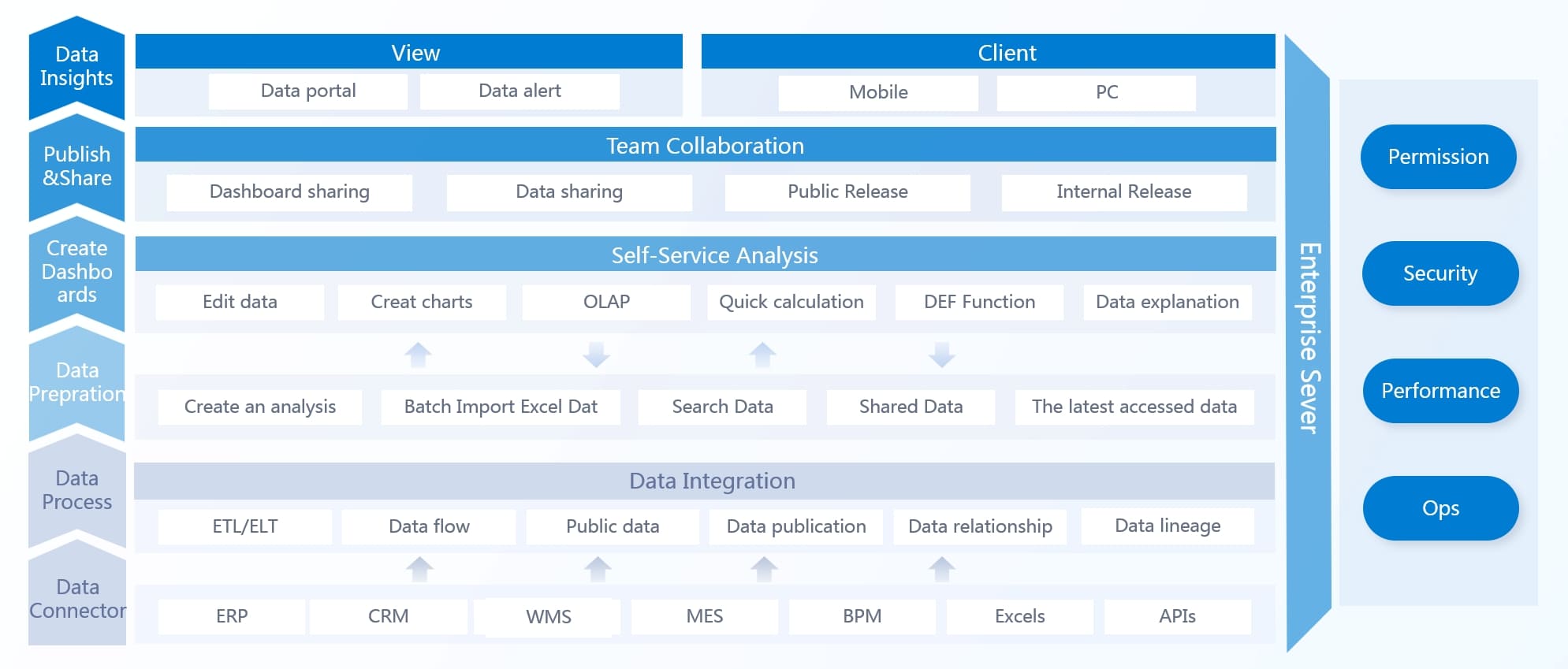
1. Simplifies Data Integration
FineBI consolidates data from multiple sources into one unified platform. Whether your data resides in relational databases, big data platforms, or Excel files, FineBI ensures seamless integration. This eliminates the hassle of switching between systems and provides you with a single source of truth. By unifying your data, you can focus on analysis rather than data preparation.
Tip: Use FineBI’s enhanced data integration capabilities to connect over 100 data sources, including MySQL, Oracle, and Hadoop. This flexibility ensures that your business intelligence efforts remain scalable and adaptable.
2. Empowers Self-Service Analytics
FineBI democratizes data analysis by enabling non-technical users to explore and analyze data independently. Its intuitive drag-and-drop interface allows you to create dashboards, perform OLAP analysis, and generate reports without relying on IT teams. This self-service approach accelerates decision-making and fosters a data-driven culture within your organization.
| Feature | Benefit |
|---|---|
| Drag-and-Drop Interface | Simplifies data exploration for users without technical expertise. |
| OLAP Analysis | Enables interactive analysis with drill-downs, linkages, and filtering. |
| Real-Time Insights | Provides up-to-date information for timely decisions. |
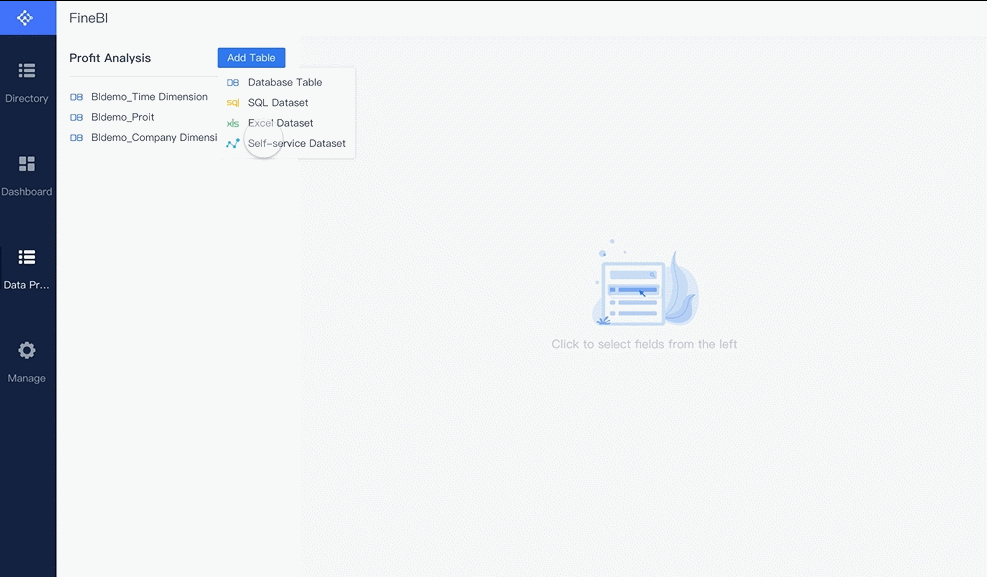
3. Enhances Data Visualization
FineBI offers over 60 chart types and 70 styles, allowing you to present data in visually compelling ways. From Gantt charts to Sankey diagrams, FineBI helps you communicate complex information effectively. These visualizations make it easier to identify trends, track KPIs, and share insights with your team.
Note: Visual storytelling through FineBI’s dashboards can improve how stakeholders understand and act on data insights.
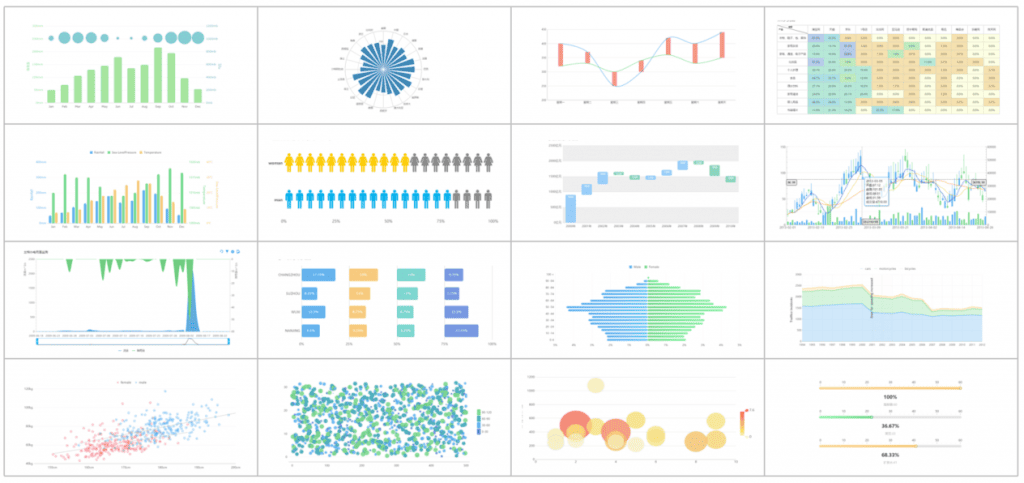
4. Strengthens Collaboration
FineBI fosters teamwork by enabling multiple users to collaborate on the same dashboard. You can share datasets, assign permissions, and even mask sensitive data to ensure security. This collaborative environment ensures that everyone in your organization works with consistent and accurate information.
5. Optimizes Real-Time Analysis
FineBI supports real-time data analysis, allowing you to respond quickly to changes in your business environment. Whether you’re monitoring sales performance or tracking operational metrics, FineBI ensures that your decisions are based on the latest data.
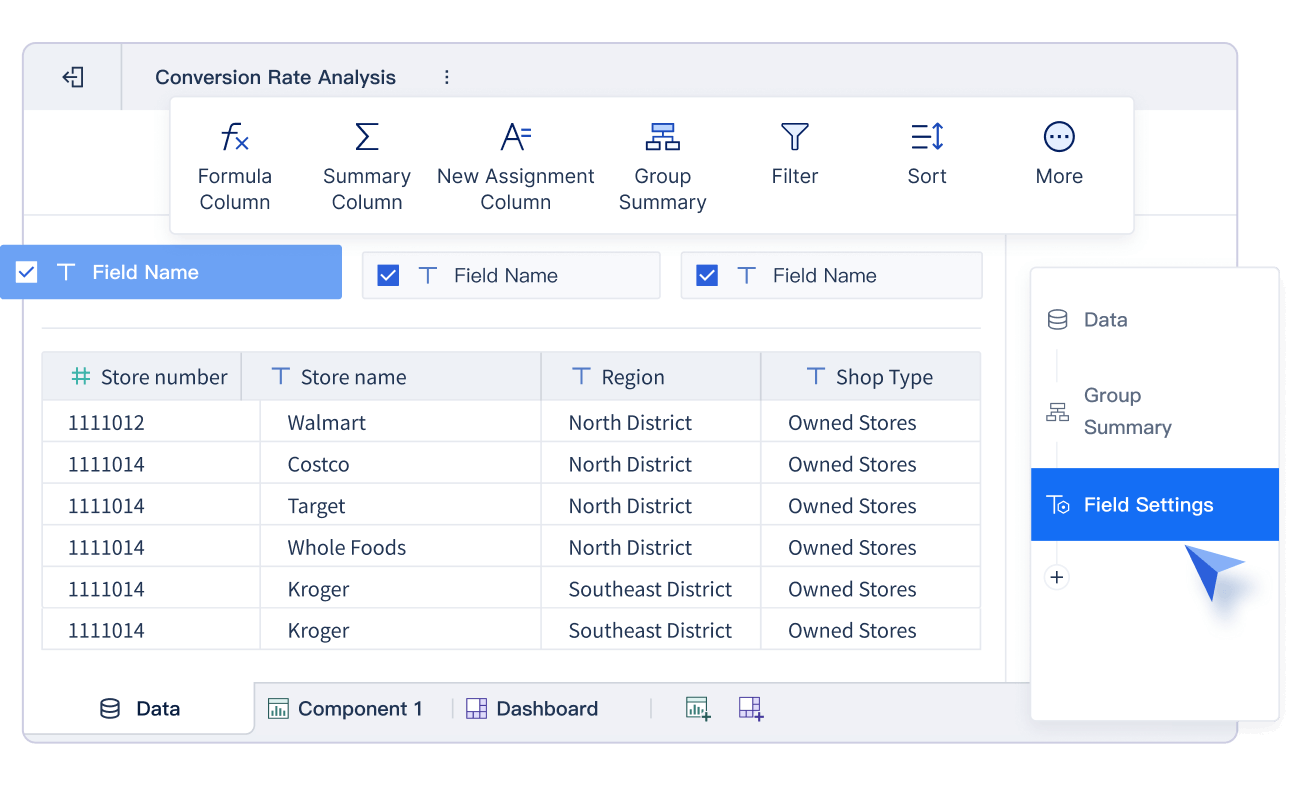
6. Scales for Enterprise Needs
FineBI’s high-performance computing engine can handle massive datasets and support over 10,000 users simultaneously. This scalability makes it an ideal choice for enterprises with complex data needs. Additionally, its role-based access control ensures that the right people have access to the right data.
By leveraging FineBI, you can elevate your business intelligence strategy. Its user-friendly design, robust features, and enterprise-level capabilities make it one of the most effective business intelligence tools available today.
Business Intelligence vs Business Analytics: What Is Business Analytics?
Definition of Business Analytics
Business analytics focuses on using data to predict future trends, optimize processes, and make strategic decisions. It involves applying statistical methods, machine learning, and predictive modeling to uncover insights that drive business growth. Unlike business intelligence, which emphasizes historical data, business analytics helps you answer forward-looking questions like "What will happen?" and "How can we make it happen?"
By leveraging business analytics, you can identify opportunities, mitigate risks, and adapt to changing market conditions. This approach empowers you to make proactive decisions that align with your business goals.
Key Features of Business Analytics
Business analytics tools offer several features that enhance decision-making and operational efficiency. These features include:
- Predictive Modeling
Predictive modeling uses historical data to forecast future outcomes. For example, you can predict customer behavior, sales trends, or operational risks. This feature helps you prepare for challenges and capitalize on opportunities. - Data Mining
Data mining involves extracting patterns and relationships from large datasets. It enables you to uncover hidden insights that can inform strategic decisions. - Real-Time Analytics
Real-time analytics allows you to analyze data as it is generated. This capability ensures that your decisions are based on the most current information available. - AI and Machine Learning Integration
Advanced business analytics tools incorporate AI and machine learning to automate processes and enhance accuracy. These technologies enable you to analyze complex datasets efficiently. - Scenario Analysis
Scenario analysis helps you evaluate different business strategies by simulating various outcomes. This feature supports informed decision-making and risk management.
Applications of Business Analytics in Enterprises
Business analytics transforms how enterprises operate by enabling data-driven decision-making across various industries. Here are some real-world applications:
- Marketing Optimization
Coca-Cola uses business analytics to refine marketing strategies. By analyzing customer preferences and market trends, the company maintains its leadership in the beverage industry. - Credit Risk Assessment
Barclays employs predictive analytics to assess credit risks. This approach reduces loan defaults and enhances financial stability. - Site Selection
Starbucks utilizes geographic information systems (GIS) and analytics to identify optimal store locations. This ensures maximum market penetration and customer convenience. - Supply Chain Management
Nike leverages predictive analytics to optimize its supply chain. By analyzing workflows and inventory data, the company adapts to market demands efficiently. - Sustainable Manufacturing
Siemens integrates AI and IoT technologies to improve energy efficiency in manufacturing. Continuous data monitoring helps reduce operational anomalies and environmental impact.
| Company | Application of Business Analytics | Description |
|---|---|---|
| Coca-Cola | Marketing Decisions | Coca-Cola uses analytics to drive marketing decisions, helping the company maintain its leadership in the global beverage market. |
| Barclays | Credit Risk Assessment | Barclays employs predictive analytics to assess credit and loan applications, analyzing various data to predict risks and reduce defaults. |
| Starbucks | Site Selection | Starbucks utilizes GIS and analytics to identify optimal locations for new stores, ensuring maximum market penetration and customer convenience. |
| Nike | Supply Chain Optimization | Nike uses predictive analytics to manage its supply chain, optimizing workflows and inventory distribution to adapt to market demands. |
| Siemens | Sustainable Manufacturing | Siemens integrates AI and IoT technologies to improve energy efficiency in manufacturing by capturing continuous data on energy use and operational anomalies. |
Business analytics empowers you to make smarter decisions, improve efficiency, and achieve sustainable growth. Whether you’re optimizing marketing campaigns or enhancing supply chain operations, business analytics tools provide the insights you need to stay ahead in a competitive market.
The Role of FineBI in Business Analytics
FineBI plays a transformative role in business analytics by equipping you with tools to analyze data effectively and make informed decisions. Its features are designed to simplify complex processes, enabling you to extract actionable insights with ease. Here’s how FineBI enhances your business analytics journey:
1. Simplifies Data Exploration
FineBI empowers you to explore data independently. Its intuitive interface allows you to perform advanced analytics without requiring technical expertise. You can drag and drop data elements to create visualizations, making it easier to identify trends and patterns. This self-service capability reduces your reliance on IT teams and accelerates decision-making.
Tip: Use FineBI’s OLAP analysis to drill down into data, filter results, and uncover hidden insights. This feature ensures you stay ahead in a competitive market.
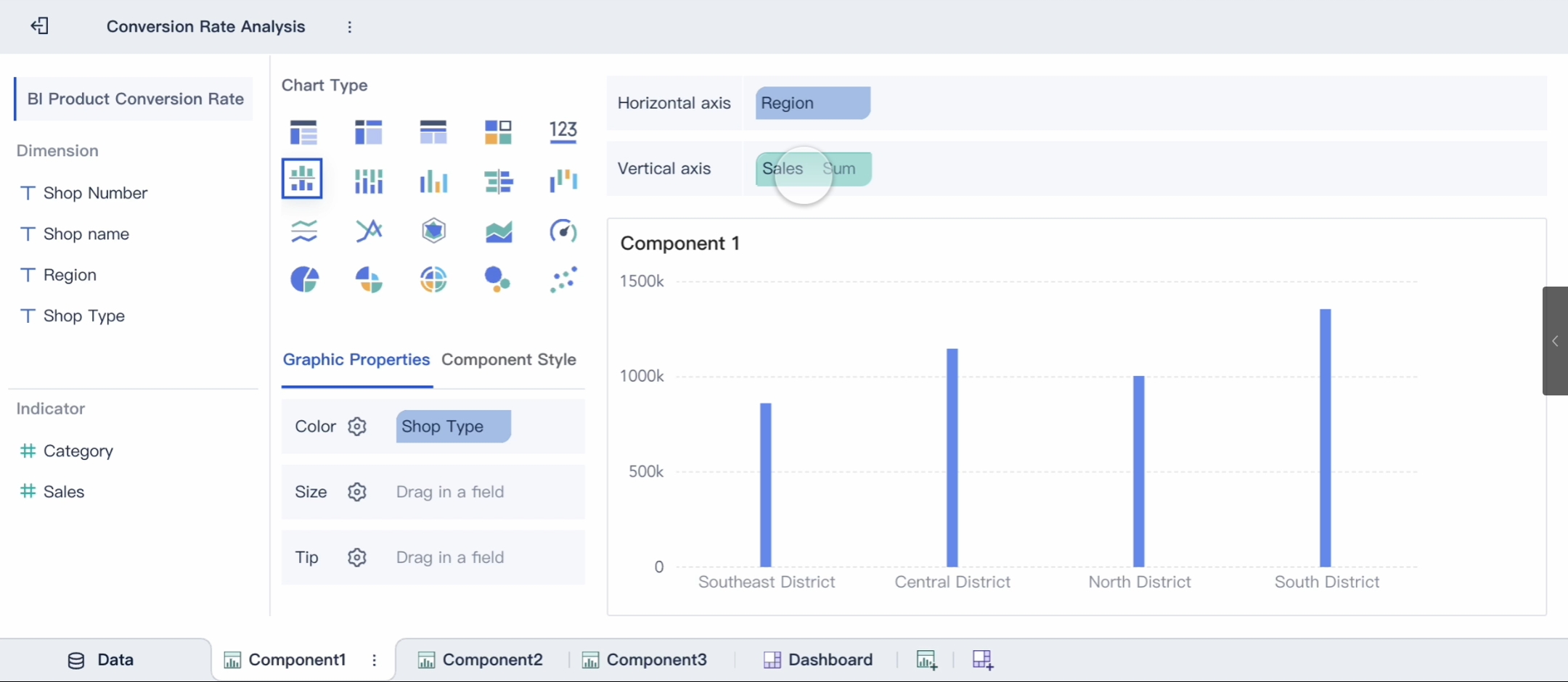
2. Enhances Predictive Capabilities
FineBI integrates seamlessly with predictive modeling techniques, enabling you to forecast future trends. By analyzing historical data, you can predict customer behavior, market demands, or operational risks. This foresight helps you prepare for challenges and seize opportunities.
| Feature | Benefit |
|---|---|
| Predictive Modeling | Helps forecast trends and mitigate risks. |
| Real-Time Analytics | Provides up-to-date insights for proactive decision-making. |
3. Supports Real-Time Analytics
FineBI ensures that your analytics are always current. With real-time data processing, you can monitor key metrics as they change. This capability allows you to respond quickly to market shifts or operational issues, keeping your business agile and competitive.
4. Facilitates Collaboration
FineBI fosters teamwork by enabling you to share dashboards and datasets with your colleagues. You can assign permissions based on roles, ensuring that sensitive data remains secure. This collaborative environment promotes consistency and accuracy across your organization.
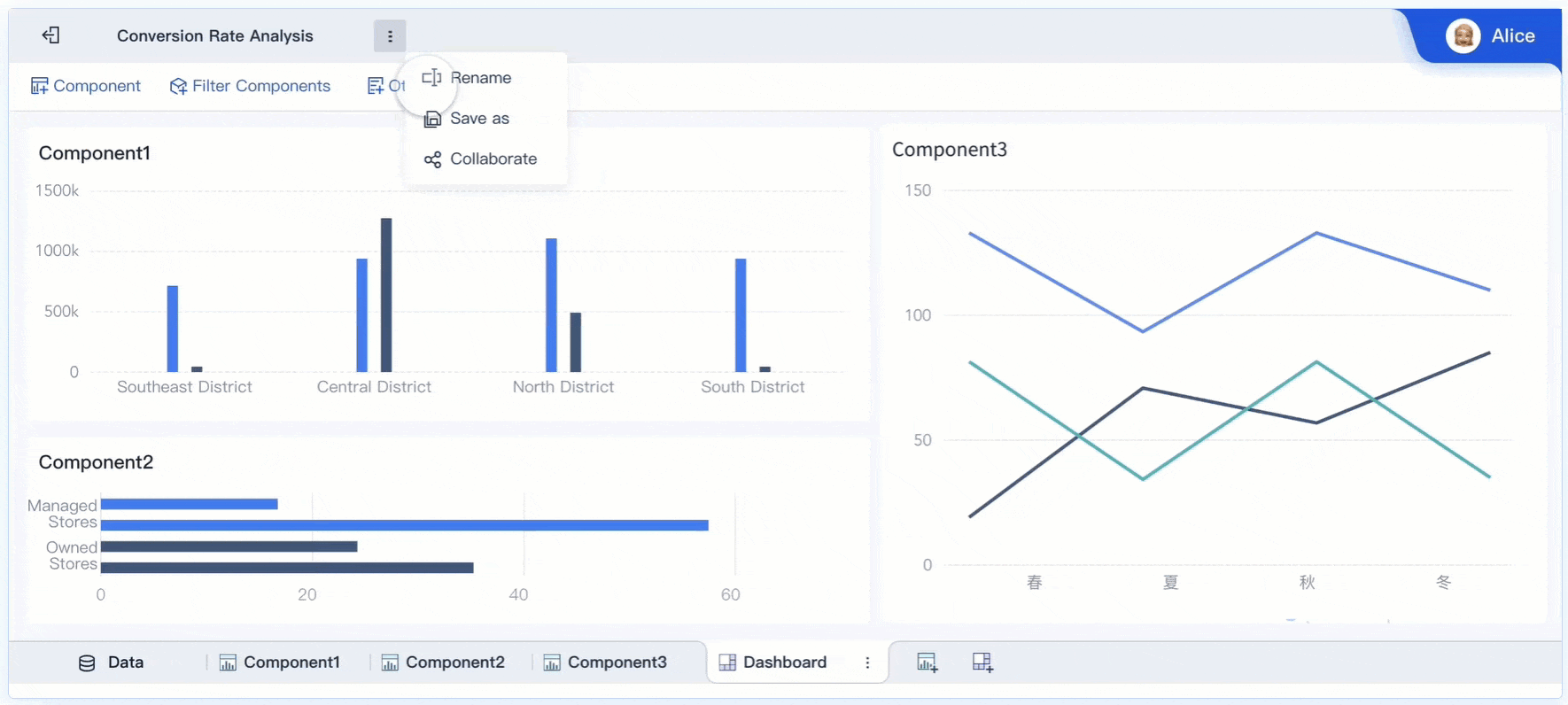
5. Scales with Your Needs
FineBI’s high-performance computing engine can handle large datasets and support thousands of users simultaneously. Whether you’re a small business or a large enterprise, FineBI adapts to your needs. Its scalability ensures that your business analytics efforts grow alongside your organization.
6. Improves Data Visualization
FineBI offers a wide range of visualization options, from bar charts to Sankey diagrams. These tools help you present complex data in a clear and engaging way. Visual storytelling through FineBI’s dashboards makes it easier for stakeholders to understand and act on insights.
Note: Effective data visualization can enhance decision-making by highlighting key trends and anomalies.
7. Promotes Data-Driven Culture
FineBI democratizes analytics by making it accessible to everyone in your organization. When every team member can analyze data independently, your company fosters a culture of informed decision-making. This shift leads to better strategies and improved outcomes.
FineBI transforms how you approach business analytics. Its user-friendly design, robust features, and enterprise-level capabilities make it an indispensable tool for modern enterprises. By leveraging FineBI, you can unlock the full potential of your data and drive sustainable growth. Now just one click and you can try FineBI for free.
Business Intelligence vs Business Analytics: Key Differences
Time Orientation: Present vs. Future
Business intelligence focuses on the present and past. It helps you analyze historical data to understand what happened and why. This approach is ideal for tracking performance metrics and monitoring ongoing operations. For example, interactive dashboards in business intelligence tools allow you to visualize current trends and make timely adjustments.
Business analytics shifts your focus to the future. It uses predictive modeling and machine learning to forecast outcomes and identify opportunities. By leveraging analytics, you can answer forward-looking questions like "What will happen?" and "How can we prepare for it?" This proactive approach enables you to stay ahead in competitive markets.
| Aspect | Business Intelligence (BI) | Business Analytics (BA) |
|---|---|---|
| Focus | Present and past | Future |
| Questions | "What happened?" | "What will happen?" |
| Tools | Dashboards and reports | Predictive models |
Data Usage: Historical vs. Predictive
Business intelligence relies on structured historical data. It organizes information into reports and dashboards, helping you identify patterns and trends. This structured approach ensures accuracy and consistency, making it easier to manage day-to-day operations.
Business analytics goes beyond historical data. It incorporates unstructured data, such as social media posts or customer reviews, to uncover deeper insights. Advanced tools like data mining and AI algorithms enable you to predict future outcomes and optimize strategies.
| Aspect | Business Intelligence (BI) | Business Analytics (BA) |
|---|---|---|
| Data Type | Structured | Structured and unstructured |
| Usage | Reporting and tracking | Predicting and optimizing |
Organizational Factors: Scalability and Integration
Scalability and integration play a crucial role in shaping your data strategy. Business intelligence tools excel in large-scale implementations. They consolidate data from multiple sources, providing a unified view for decision-making. For example, cloud-based solutions enhance scalability by accommodating growing data needs.
Business analytics tools offer flexibility for targeted use cases. They integrate seamlessly with modern platforms, enabling you to analyze diverse data formats. Modern data management tools improve scalability and address integration challenges. They also ensure data security and governance, which are vital for effective analytics strategies.
| Evidence | Description |
|---|---|
| Workflow and Processes | Efficient management of patient data is crucial for scalability in health information systems. |
| Resource Allocation | Adequate staffing and resources are necessary to support growth and changes in health information systems. |
| Data Governance | Clear policies for managing data quality and privacy are essential for effective scalability. |
Tip: Use modern data integration tools to streamline processes and improve data quality. This approach ensures your organization remains agile and adaptable.
Trends in Business Intelligence vs Business Analytics
The fields of business intelligence (BI) and business analytics (BA) are evolving rapidly. Staying updated on the latest trends ensures that you remain competitive and make the most of your data strategies. Here are some key trends shaping the future of BI and BA:
- AI-Powered Analytics
Artificial intelligence (AI) is transforming how you analyze data. Tools now use AI to automate data preparation, identify patterns, and generate insights. This reduces manual effort and speeds up decision-making. For example, FineBI integrates AI to enhance data interpretation, helping you uncover trends effortlessly. - Real-Time Data Processing
Businesses increasingly rely on real-time analytics to respond quickly to changes. Whether monitoring sales or tracking customer behavior, real-time insights allow you to act immediately. FineBI’s real-time analysis capabilities ensure you always work with the latest data. - Self-Service BI and BA
Self-service tools empower non-technical users like you to explore data independently. This democratization of analytics fosters a data-driven culture within organizations. FineBI’s intuitive interface makes self-service analytics accessible to everyone. - Data Governance and Security
As data volumes grow, ensuring its quality and security becomes critical. Modern BI and BA tools emphasize robust governance frameworks. These frameworks help you manage permissions, protect sensitive information, and comply with regulations. - Predictive and Prescriptive Analytics
Predictive analytics helps you forecast future trends, while prescriptive analytics recommends actions. These advanced techniques enable you to make proactive decisions. FineBI supports predictive modeling, giving you a competitive edge.
Tip: Adopting these trends can enhance your organization’s agility and decision-making capabilities. Start by exploring tools like FineBI to stay ahead in the data-driven era.
By embracing these trends, you can unlock the full potential of your data and drive innovation across your enterprise.
Business Intelligence vs Business Analytics: Choosing the Right Approach for Your Enterprise
Factors to Consider: Business Goals and Resources
Choosing between business intelligence and business analytics starts with evaluating your business goals and available resources. Business intelligence helps you analyze historical data to improve operational efficiency and monitor performance. Business analytics focuses on predicting future trends and optimizing strategies.
To make an informed decision, consider the following metrics:
| Metric Type | Description | Considerations |
|---|---|---|
| Qualitative | Focuses on understanding experiences and underlying factors. | Requires skilled researchers and time for interviews and thematic analysis. |
| Quantitative | Provides clear and objective benchmarks for comparison and decision-making. | Necessitates a larger sample size and statistical expertise. |
Additionally, quantitative methods can help you:
- Quantify possible outcomes for business issues.
- Assess the probability of achieving specific objectives.
- Plan schedules and budgets effectively.
- Provide objectivity in decision-making, which strengthens management strategies.
Tip: Align your choice with your enterprise's priorities. If your goal is to streamline operations, business intelligence may be the better fit. For forecasting and innovation, business analytics offers greater value.
Career Outcomes: Roles and Skills in Business Intelligence vs Business Analytics
The career paths in business intelligence and business analytics differ significantly. Business intelligence roles include project managers, consultants, directors, and analysts. These positions require proficiency in BI tools and strong communication skills to present findings effectively.
Business analytics, on the other hand, demands high-level talent to transform data into actionable insights. Analysts in this field often work with predictive models and machine learning algorithms. Many organizations still rely on outdated technologies, creating opportunities for skilled professionals to modernize analytics processes.
| Career Path | Key Skills Required |
|---|---|
| Business Intelligence | Expertise in BI tools, data visualization, and effective communication. |
| Business Analytics | Proficiency in predictive modeling, machine learning, and advanced statistical techniques. |
Note: Both fields offer lucrative career opportunities. Business intelligence focuses on maximizing profits through historical data analysis, while business analytics emphasizes innovation and future-oriented strategies.
Business Intelligence vs Business Analytics: Decision-Making Framework for Enterprises
How FanRuan and FineBI Support Enterprise Decision-Making
FanRuan and FineBI revolutionize enterprise decision-making by providing tools that transform raw data into actionable insights. These solutions empower you to make informed choices, optimize operations, and achieve strategic goals.
1. Unified Data Integration
FanRuan’s FineBI consolidates data from diverse sources into a single platform. This integration eliminates data silos, ensuring you have a comprehensive view of your business. FineBI supports over 100 data sources, including MySQL, Oracle, and Hadoop, making it adaptable to your organization’s unique needs.
Tip: Use FineBI’s seamless data integration to unify your data and focus on analysis rather than preparation.
2. Real-Time Insights for Agility
FineBI enables real-time data analysis, allowing you to monitor key metrics as they change. This capability ensures that your decisions are based on the most current information. Whether tracking sales or operational performance, FineBI keeps you ahead of the curve.
3. Enhanced Collaboration
FineBI fosters teamwork by enabling multiple users to collaborate on dashboards and datasets. You can assign permissions based on roles, ensuring data security while promoting consistency across teams.
| Feature | Benefit |
|---|---|
| Role-Based Permissions | Protect sensitive data while enabling collaboration. |
| Shared Dashboards | Ensure all team members work with consistent information. |
4. Predictive Analytics for Strategic Planning
FineBI integrates predictive modeling, helping you forecast trends and identify opportunities. By analyzing historical data, you can prepare for challenges and make proactive decisions.
Note: Predictive analytics helps you stay competitive by anticipating market changes.
FanRuan and FineBI empower you to harness the full potential of your data. Their user-friendly design, robust features, and scalability make them indispensable for modern enterprises. By adopting these tools, you can drive innovation, improve efficiency, and achieve sustainable growth.
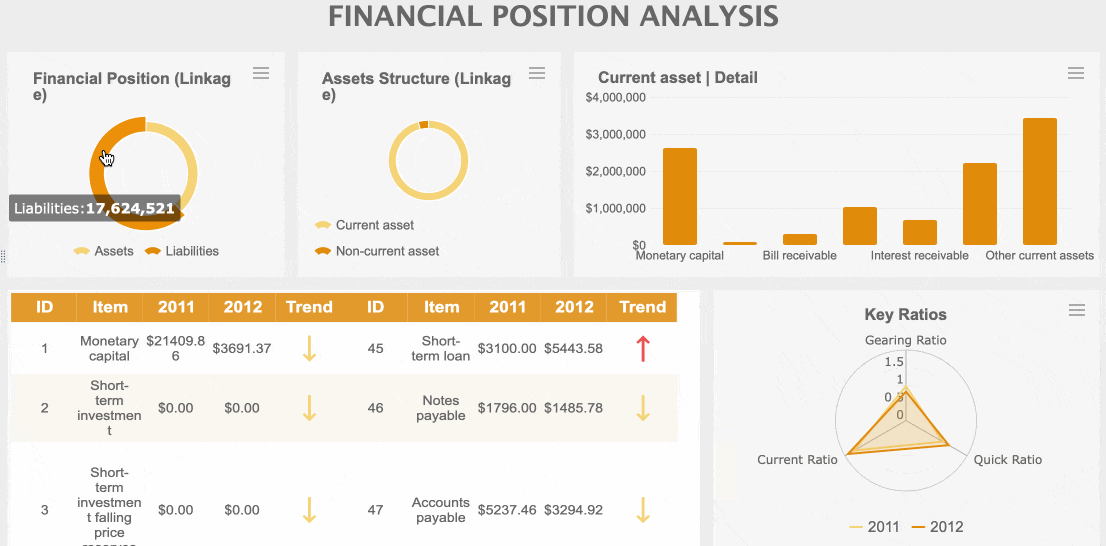
Understanding the differences between business intelligence and business analytics is essential for modern enterprises. Business intelligence focuses on analyzing past data to meet current business needs, while business analytics predicts future outcomes to optimize operations. The table below highlights their distinctions:
| Aspect | Business Intelligence | Business Analytics |
|---|---|---|
| Focus | Examines past data to drive current business needs. | Analyzes past information to predict future outcomes. |
| Purpose | To run current trade operations. | To alter trade operations for future efficiency. |
| Tools | SAP Trade Objects, QlikSense, PowerBI, etc. | Statistical analysis tools, data science software, etc. |
| Application | Applies to all large-scale companies for current operations. | Applies to companies focused on future development. |
| Key Skills | Data collection, management, and understanding diverse data sources. | Objectives setting, communication skills, and analytical thinking. |
Aligning your data strategy with enterprise goals ensures that your organization remains competitive. For example, if your goal is operational efficiency, business intelligence tools like dashboards and reports can help. If your focus is innovation, business analytics tools with predictive modeling capabilities are ideal.
To choose the right approach, assess your business objectives and resources. Start small by integrating tools like FineBI, which supports both business intelligence and business analytics. This ensures scalability as your needs evolve. Click the banner below to try FineBI for free and empower your enterprise to transform data into productivity!
Continue Reading About Business Intelligence vs Business Analytics
Business Intelligence Solution: A Comprehensive Guide
What is Enterprise Business Intelligence
Demystifying Business Analytics Software: 2024 Tools Comparison
FAQ

The Author
Lewis
Senior Data Analyst at FanRuan
Related Articles

What Are Enterprise BI Solutions and How Do They Work
Enterprise BI solutions unify business data, enabling real-time analytics, secure collaboration, and smarter decision-making across your organization.
Lewis
Dec 22, 2025

What is a BI Dashboard and Why Does Your Business Need One
A BI dashboard centralizes business data, tracks KPIs, and delivers real-time insights, empowering smarter decisions and boosting business performance.
Lewis
Dec 19, 2025

Power BI vs Tableau Which Analytics Platform Wins
Power BI vs Tableau: Compare features, pricing, and integration to see which analytics platform best fits your business and data visualization needs.
Lewis
Dec 19, 2025
